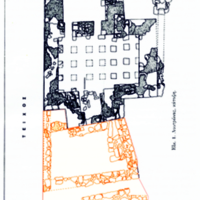Baths
POI Item Type Metadata
Latitude
40.932114
Longitude
24.971725
WebContent
Baths
The baths which were found in the western interior side of Polystylon walls.
In the Byzantine Polystylon, one of the oldest buildings, now in ruins, it's this small bath. It is dated in the 4th-5th century. Public baths during the Roman era and also in Byzantine times were of particular importance for the social life of the inhabitants of a city. As distinguished in the given figure,the baths consist of three distinct areas: the entrance and the bathers locker, the middle main space, with very thick walls and with a raised floor (hypocaust), which are the main heated baths,and on the south side,it is the third space,the focal point of the baths, which provides with warm air and water, the bathroom areas.
The middle room (caldarium) has dimensions 4,05m x 2,65m and retains some of the hypocaust. Specifically, two rows of brick, four-sided small pillars on the floor, with four small pillars,each with 0,47m height are preserved. The room seems it had seven sets with four or five small pillars in each row. The bottom of the hypocaust is paved with clay tiles.A clay square cross-section pipe for the air drawing enters the eastern wall of the room, covered with stone slabs without mortar.
Finally, on the south side of the baths,there is the "focal point" with the feeding tube (praefurnium), in which two building phases are distinguished. The south wall and a small section of the eastern wall belong to the first phase.
The baths date approximately in the 4th century. However, two bronze Aurelian coins (270-275 AD), were found in the mortar of the south wall of the south space during the second building phase, a fact which shifts probably earlier the constuction of this public bath.
The baths which were found in the western interior side of Polystylon walls.
In the Byzantine Polystylon, one of the oldest buildings, now in ruins, it's this small bath. It is dated in the 4th-5th century. Public baths during the Roman era and also in Byzantine times were of particular importance for the social life of the inhabitants of a city. As distinguished in the given figure,the baths consist of three distinct areas: the entrance and the bathers locker, the middle main space, with very thick walls and with a raised floor (hypocaust), which are the main heated baths,and on the south side,it is the third space,the focal point of the baths, which provides with warm air and water, the bathroom areas.
The middle room (caldarium) has dimensions 4,05m x 2,65m and retains some of the hypocaust. Specifically, two rows of brick, four-sided small pillars on the floor, with four small pillars,each with 0,47m height are preserved. The room seems it had seven sets with four or five small pillars in each row. The bottom of the hypocaust is paved with clay tiles.A clay square cross-section pipe for the air drawing enters the eastern wall of the room, covered with stone slabs without mortar.
Finally, on the south side of the baths,there is the "focal point" with the feeding tube (praefurnium), in which two building phases are distinguished. The south wall and a small section of the eastern wall belong to the first phase.
The baths date approximately in the 4th century. However, two bronze Aurelian coins (270-275 AD), were found in the mortar of the south wall of the south space during the second building phase, a fact which shifts probably earlier the constuction of this public bath.
Entrance
Characterization
AH
Files
Collection
Citation
“Baths,” iGuide Repo, accessed December 5, 2025, http://ubuntu01.ceti.gr/omeka/items/show/971.
Item Relations
| This Item | dcterms:isPartOf | Item: Abdera |
| Item: Baths | dcterms:isPartOf | This Item |
| Item: Baths | dcterms:isPartOf | This Item |
| Item: Baths | dcterms:isPartOf | This Item |
| Item: Baths | dcterms:isPartOf | This Item |




